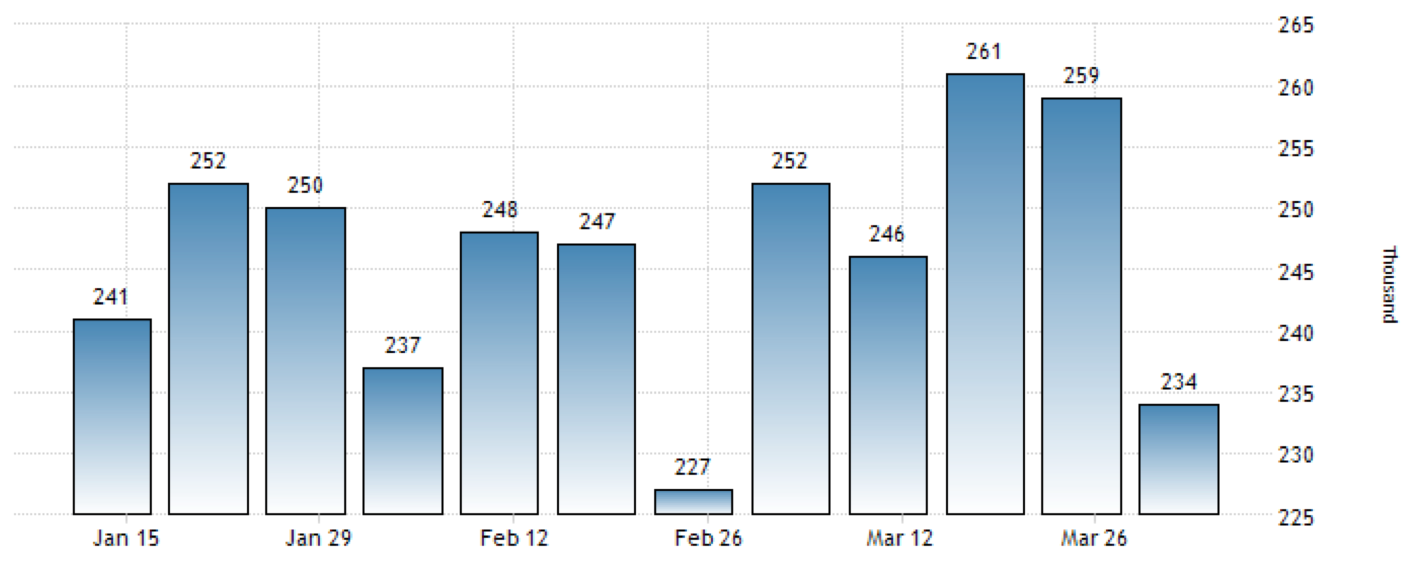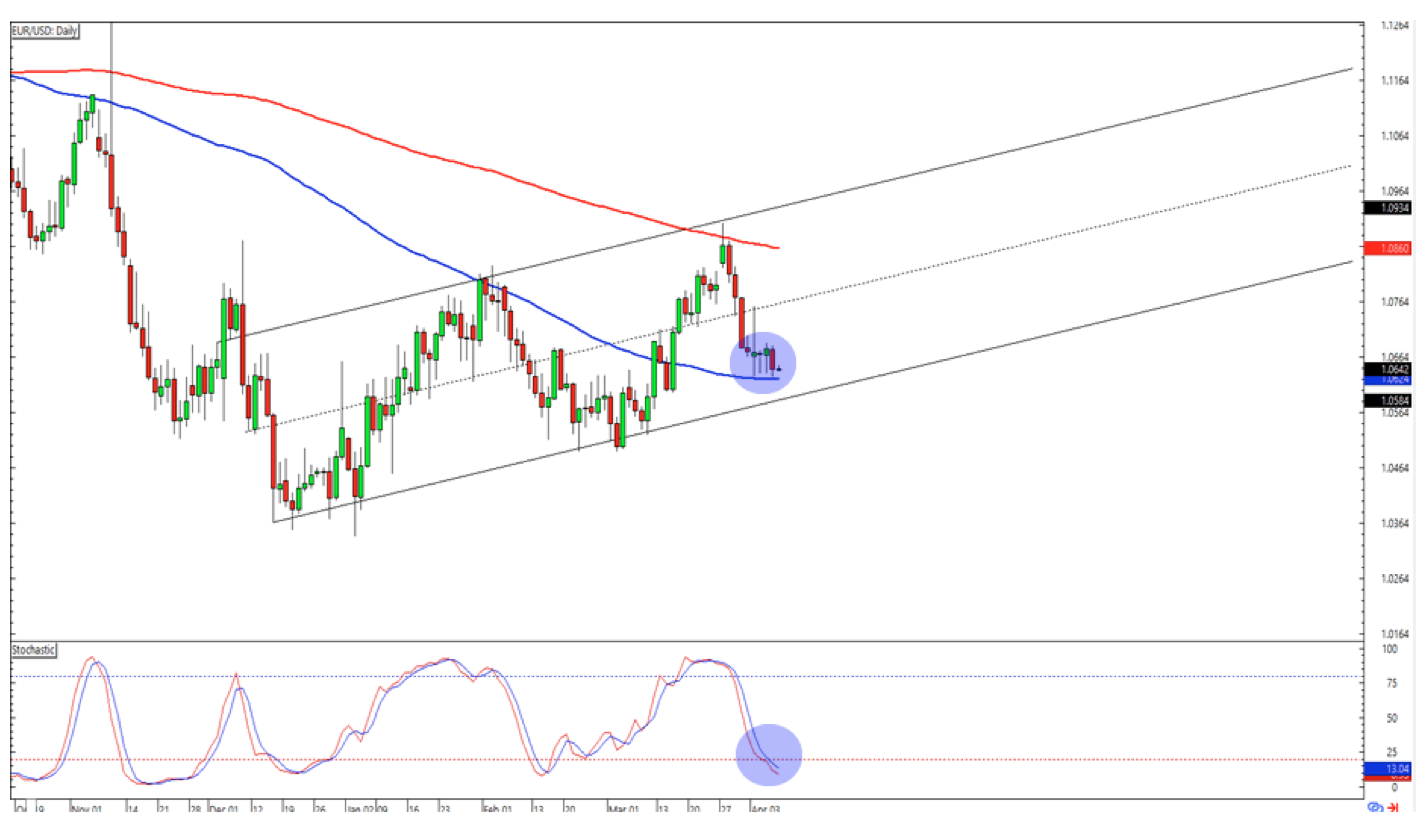Daily Insights Report 07/04/17
- 7 Apr 2017
US Jobless claims showed to be at a 5-week low. The number of Americans filing for unemployment benefits decreased by 25,000 to 234,000 in the latest week. This is below the expectation of 250,000 claims. This is the largest decline since April 2015. The 4-week moving average that removes week-to-week volatility fell by 4,500 to 250,000. A graphical interpretation of this data can be seen in the chart below.

– The Dollar edged up slightly by 0.1% against the Yen to reach 110.78 after giving back a solid advance against the Yen on Wednesday.
– The Euro was 0.2% weaker against the Dollar at $1.0642 after reaching a three-week low of $1.0630 as the markets received the comments by the president of the European Central Bank – Mario Draghi.
Commodities
– Oil prices moved higher again as participants in the market looked ahead of the US crude inventories. Brent settled at $54.89 a barrel, which represents a gain of 1% compared to the previous day. This is not far from Wednesday’s one-month intraday high of $55.09. West Texas Intermediate (WTI) crude was 1.1% higher in trading and reached $51.69 per barrel.
– Gold jumped 1% to reach $1,264.74 an ounce. This is the highest level reached since November, following two days of declines.
Euro (EUR)
Spain – Industrial Production (February)
Spain’s industrial production likely gained 0.2% in February after a 0.3% month-over-month gain in the first month of this year. Compared to this time last year, there is an increase of 3.1%, as Spain has advanced its economy. Spain’s manufacturing PMI softened slightly in February to 54.8 from 55.6 in the previous month. Comparatively, the Euro area’s manufacturing PMI rose to a 70-month high. Economic fundamentals remain healthy in Spain, as there was a 3.2% growth rate in 2016, which is much higher than other European nations.
Italy – Retail Sales (February)
High unemployment and poor wage growth have impacted retail sales, and this is why we are likely to see the data shrink by 0.4% month-over-month in February. Even though Italy’s economy has been steadily growing since 2014, unemployment remains high (11.9% in January) – the highest since June 2015. Combined with high unemployment, wage growth has not been great either, which is impacting household spending. Annual wage growth in Italy has been negative, the lowest among the Euro zone countries. Labor productivity would ideally need to grow for wages and salaries to rise.
Germany – Industrial Production (February)
Industrial production in Germany likely dipped in February after a small recovery at the beginning of the year. however, comparing to the previous year, production likely rose. Weak demand will keep industrial production from growing quickly. German manufacturing orders plummeted unexpectedly in January. However, Germany’s Markit manufacturing PMI for February rose to a 69-month high of 56.8 from 56.4 in January, showing that business conditions will likely improve in the coming months. Details of the report showed that new orders grew for the 27th consecutive month, which is at the highest pace since January 2014, with external demand coming up from Asia and Europe. Demand from outside the Euro should strengthen in the coming months because of the overall weaker Euro.
United States Dollar
Employment Situation (March)
Looking at nonfarm employment, it has risen by 160,000 in March, compared with the average of 194,000 in the past six months. This is still a solid gain in employment above the 100,000 level which is needed to keep up with the growth in the working-age population.
Job growth could also be affected by the federal government hiring freeze. President Trump signed an executive order in late January mandating that no vacant positions existing at noon at January 22, 2017 could be filled or created, except in limited circumstances. The result of this impact is that it will negatively impact job growth. It is expected that there will be a decline of 5,000 in federal employment.
Hourly earnings for all private workers is likely to show a rise of 0.2%, which matches the gain in each of the prior two months. This will leave average hourly earnings up 2.7%.
Technical Analysis
EURUSD
Looking at the daily chart of this pair, we can see the downward trend is flattening, although it is still continuing in this direction. This comes around the 1.0650 area of the rising channel, which can be the reason of the flattening of the averages. The stochastic indicators suggest that the currency pair is currently oversold. With the Euro likely to strengthen in the medium-long term due to improving economic prospects, buying this currency pair now with a target of 1.08 may be feasible.


